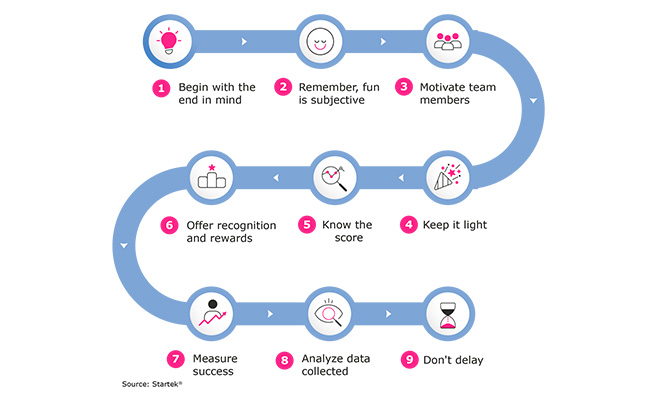What is call center gamification?
In the dynamic landscape of customer service, the pivotal role of contact center agents cannot be overstated. These frontline heroes serve as the face and voice of organizations and are tasked with delivering exceptional experiences to customers across various channels. However, in today’s rapidly evolving environment, where customer expectations are continually rising and remote work models are becoming increasingly prevalent, empowering contact center agents to excel in their roles has become more challenging than ever. One powerful strategy that has emerged to address this challenge is gamification.
By infusing elements of playfulness and competition into the daily tasks of agents, gamification transforms mundane activities into engaging experiences, driving higher levels of productivity, motivation and performance. This innovative approach not only benefits individual agents but also contributes to the overall success of the contact center, ultimately enhancing the customer experience.
Gamification, the act of transforming an otherwise mundane task into a playful — but still productive — activity is an increasingly popular way to modernize the workplace and make it more attractive and pleasant. It’s especially useful in training, where recall of specific details is required and is an effective way to reinforce ideas, procedures and concepts in a light and playful manner.
Call center gamification can play several roles, all of which provide value to agents, clients and customers. By its nature, gamification is a potent employee engagement tool. It boosts involvement by incentivizing specified behaviors and promotes positive performance through interactive games that can be played by many agents across multiple locations. This not only improves individual engagement and performance but is also a catalyst for promoting a sense of teamwork and connectedness across several geographies. Engaged agents are an important component of a positive customer experience in call centers, too.
Why gamify?
Boosting agent engagement reduces turnover. With a contact center employee attrition rate of 42%, gamification isn’t just an option; it’s a necessity. It’s also a painless way to boost productivity. Gamification can increase company productivity by up to 50% and employee engagement by 60%, and 72% of people believe that gamification inspires them to work harder, per Salesforce. In addition, it is a powerful learning tool. Gamification increases employees’ ability to learn by up to 40%.
What gamification can do for your call center
Here are the top ways gamification can improve engagement and performance in call centers:
- Attendance
- Training and coaching
- Analytics (hold times, wait times, first-call resolution, etc.)
- Average Handle Time (AHT)
- Overall performance
- Upselling
- Call volume
- Call transfer rates
- Call duration
- Length of call queues
- Missed calls
- Customer satisfaction/feedback
Devising gamification approaches for call centers
The idea is to make the games challenging but not unwinnable, so choose those that are simple, familiar and instructive while still being challenging and engaging. Adapting current popular games shortens the learning curve and increases acceptance and adoption. They needn’t be current. Traditional favorites such as Bingo can be easily adapted and any game that involves knowledge, skills and points works well. Cumulative scoring that pits different call center agents, teams and locations against each other makes gamification even more effective and competitive. Be creative!

Nine steps to successful call center gamification
- Begin with the end in mind
- What are the results you seek to achieve?
- What constitutes success (or failure)?
- What actions must be completed?
- How much time should each action take?
- What are the variables, including agent and customer options and preferences?
- Are there any “aha!” moments that can be built into the game?
Your purpose in developing a game defines the need and the desired performance goals and KPIs. These are the first steps for devising a call center gamification initiative. Once they have been determined, the next thing is to consider questions, responses and tasks that will encompass these things, along with making the game interesting, worthwhile and useful to agents.
Top subjects for call center gamification
- Training content
- Process steps
- Product knowledge
- Personal goals
- Assessment targets
- HR rules
- Upselling
- Efficiency
- Teamwork
- Communication
- Sales performance
- Fun is subjective
We all have personal likes and dislikes. So, too, do each of us have different things that amuse or entertain us. When you create your game, you must keep this in mind. Since tastes and values vary, starting with a low (but not the lowest) common denominator is often wise. Rather than beginning with a game that requires highly specialized knowledge or ability, starting with simple tasks and responses will generate greater acceptance and adoption by call center agents. But don’t make it too simple or it will be immediately rejected. Find a moderate level of knowledge needed by involving line managers early in the process, as their input and reaction will serve as a good guide to what is and what is not acceptable. Then build on that with more complex questions.
- Motivate
Other than the game itself, decide upfront how you want to motivate and reward the players. Points, prizes and other rewards ensure call center agents are engaged and incentivized to continue playing beyond an initial encounter. (See below for prize suggestions.) Competition is important, so be sure the games are playable across call centers in multiple geographies. Do not minimize the power of competition and the egos of players! Harness those drivers (in a good way!) Be sure to recognize (and reward) winners and publicize the results to ensure repeated plays.
- Keep it light
If the questions and tasks are too technical, complicated and overly formal, a poor reaction is virtually guaranteed. The style of the games and how the steps are communicated should be light — even whimsical. Goals must be straightforward and unambiguous, which serves two purposes: The agent clearly knows when they’ve “won” and what they’ve learned or achieved. Second, the analytics derived from this are also clear. Certainly, as the games proceed, they can and should be more specific and “serious” but the tone must remain light and playful to maintain the status as a “game” and not an exam or test, at least from the agents’ perspective.
- Know the score
Decide on a way to keep score and update regularly to build competitiveness
- Points
- Game levels
- Leaderboards
- Number of calls made or taken
- Completed sales
- Dollars (value of sales, upsells, etc.)
- Money saved
- Badges
- Ranking/ratings
Consider the value of each point and “win,” how agents score (or lose points) and what it takes to win or complete the game.
- Recognition and rewards
Decide how you want to reward gamers. Recognizing them is the first step. Allow them to experience some glory and achievement. Publicize their success throughout your organization. Encourage other agents to use their accomplishments as motivation for their pursuits, too. Competition is a powerful source of inspiration. Reward success with prizes in the form of points, cash, holidays, gifts — whatever you think is appropriate and will be valued by agents. Rewards and recognition are powerful tools for boosting employee engagement, so put some thought into the process.
Here are some prize suggestions:
- Cash and gift cards to local and online retail shops
- Vacation or PTO days
- Meals or snacks
- T-shirts, caps, banners
- Virtual rewards (points, badges, etc.)
- Avatar enhancements (clothing, accessories, appearance, etc.)
- Or anything else of value, based on your location, business and culture
- Measure success
Metrics derived from agent gamification are ideal for subsequent analysis. Virtually any activity can be measured but it is important to focus on ones within agents’ control, not those determined primarily by external conditions. Your purpose in developing a game determines its scoring systems and objectives, based on the importance. So too, should your analysis be weighted according to these goals.
- Analyze this
Gamification isn’t all fun and games. It’s business, too. The data you pull from gamified activities will tell you many things. For example, a view of gamified performance data helps managers assess productivity and other standards. The ability to monitor employees, optimize performance and schedules, and identify high-performing agents are facilitated through gamification.
- Ready, set, go!
It’s never too late to start the gamification process. The current generation(s) of employees grew up with games in just about every aspect of their lives. It’s clear that agents and contact centers benefit from its implementation in multiple ways. And since its popularity is spreading across many industries, there’s no reason to put it off any longer. To get started, you need a partner who understands contact centers and knows gamification.
Abhinandan Jain, Chief Growth Officer, Startek®, brings a wealth of experience in technology, manufacturing, insurance, telecom and more. With a focus on AI, automation, cloud computing and analytics, he leads global sales, marketing, and digital solutions. Abhinandan drives revenue growth and fosters client relationships, embodying a digital-first approach essential for Startek success. Beyond his corporate role, he actively engages in community initiatives, serving as a board advisor for universities and a mentor in entrepreneurship.
About Startek®:
Startek®, with over 35 years of experience, is a global leader in delivering customer experience excellence for renowned brands across 12 countries. With 38,000 associates, Startek offers personalized experiences in voice and non-voice channels, serving clients ranging from Fortune 500s to fast-growing startups in various sectors, including cable, media, telecom, travel, hospitality, retail, e-commerce, and banking. By fostering closer connections, Startek delivers value for clients, opportunities for its people, and sustainable growth for shareholders. To learn more, visit www.startek.com



